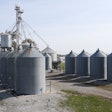
Feed mill profitability cannot be simply defined as reducing processing input costs. While input costs are certainly important to consider, it is equally important to recognize that it takes money to make money. If feed mill production rate and/or feed quality are sacrificed in order to save money, the virtual savings will not translate into increased profits.
Based on an ad hoc unpublished industry survey conducted at Kansas State University, production rate is the primary driver behind feed processing costs, and thus, at least one-half of the “profitability equation.” The more tons that fixed-costs can be spread over, the lower the production costs per ton.
Production rate
As an example, consider costs associated with pelleting when comparing commercial feed mills to integrated feed mills. It costs a commercial feed mill roughly $8 to $10 per ton to pellet. With an integrated feed mill, pelleting costs are approximately $3 to $4 per ton. Note the substantial difference between these two estimated costs.
Generally speaking, in a commercial feed mill a large variety of different formulas are produced. Much greater attention is given to pellet quality, and it is necessary to do things such as change the pellet die, which results in greater down time. Conversely, in an integrated feed mill, there are fewer formulas and less processing downtime which results in greater tonnage. Based on this, it is logical to conclude that the differences in pelleting costs mentioned above correlate with production rate. To the point, if, for example, postponing the purchase of rolls for a pellet mill, or hammers for a hammermill, result in declined production rate, the input costs may be less, but so is overall profitability.
With this in mind, I would not recommend trying to save money by avoiding preventative maintenance. Many have made this mistake, and it only results in extra headaches and frustrations. This move has been estimated to cost roughly five-fold in the long run. The overall cost of a good preventative maintenance program represents very little, and should not be ignored to save money in order to meet quarterly expense report expectations.
Energy savings
As mentioned earlier, input costs are an important component to the “profitability equation.” To that end, it makes little sense not to pay careful attention to energy usage wherever possible. In the last few years the news has offered up numerous discussions related to climate change and greenhouse gas emissions. I have been invited to discuss this topic relative to how potential environmental policies will impact the feed industry. The short answer is, I’m not entirely sure; however, pursuing sustainability and conservation of energy makes good sense from an economical perspective, regardless of the politics.
Paying attention to details will financially add up over time, particularly when it comes to energy conservation. For example, one feed mill that I am aware of was having issues associated with faulty steam-traps. They invested in fixing the problem, and as a result, saved approximately $9,000 a year in utility costs. Due diligence will pay off when it comes to energy conservation. My advice: make sure your steam system is well maintained, insulate the steam lines, fix malfunctioning steam traps, invest in energy efficient motors and work with your utility company to find ways of reducing costs.
Importance of housekeeping
It would be difficult to place an accurate economic value on a good housekeeping program. However, I believe that good housekeeping increases the profitability of a facility in multiple ways. First, no one likes to start the work day with an impending mess on their hands. In my opinion, poor plant sanitation negatively affects employee attitude and ultimately lowers production efficiency. Secondly, sloppy housekeeping tends to jeopardize employee safety, which results in greater lost-time accidents, which costs the feed mill in many different ways.
Third, poor housekeeping is usually accompanied by pest management problems. I can assure you from personal experience that rodents can cause a great deal of damage to a facility, particularly to the electrical system. It is kind of ironic; in our facility the mouse for one of our computers was chewed in two by a mouse. Not only is pest control a profitability issue, it is a food safety issue. Pest control does not represent a large cost; it just requires time and diligence.
Data collection
Another area that will indirectly pay dividends is good data collection and record keeping. The old management adage says “You cannot control what you do not measure; you cannot measure what you don’t define; you cannot improve what you do not control.” Pay attention to the quality and nutritional profiles of inbound ingredients. Carefully track product inventory and manage shrink. It has been my general observation that feed mills that keep good, organized records and utilize the information to their advantage seem to operate more efficiently.
Feed quality
I mentioned earlier that if feed mill production rate and/or feed quality are sacrificed to save money, the virtual savings will not translate into increased profits. I have addressed the importance of production rate. However, I have not yet discussed feed quality as it relates to profitability, and the importance of feed quality is commonly overlooked relative to profitability.
This is particularly true in the context of pelleted feed produced in an integrated feed mill, where increasing production rate and decreasing input costs are seemingly the primary focus. By the time the feed reaches the animal, there is little evidence that the feed ever came into contact with a pellet mill. I’m not trying to be critical, but I think feed/pellet quality is an equally important component to profitability, particularly when ingredient prices are high. For example, if feed efficiency is improved by approximately 6% by feeding pelleted feed verses mash, and ingredient costs are $300 per ton, pelleting represents a return on investment of $18 per ton (6% of $300). However, most data would suggest, at least with swine and poultry production, that the positive feed efficiency response obtained by feeding pelleted feed verses mash diminishes sharply as pellet quality deteriorates.
In my opinion, processing costs are largely driven by production rate. However, feed quality dictates return on investment from an animal performance perspective. Therefore, profitability is a balance between production rate and feed quality.
Details
In my mind, feed mill profitability boils down to paying attention to details while keeping the big picture in mind. In other words, saving a few dollars in one place may end up costing you in the long run. Conversely, spending a few dollars in the right place can result in significant dividends.

















